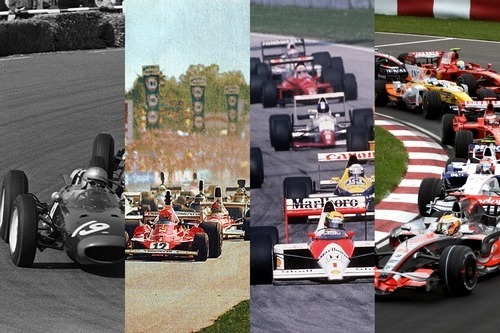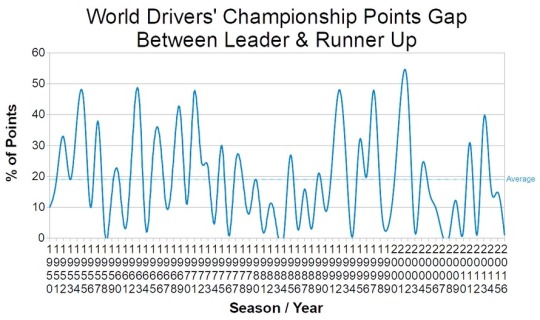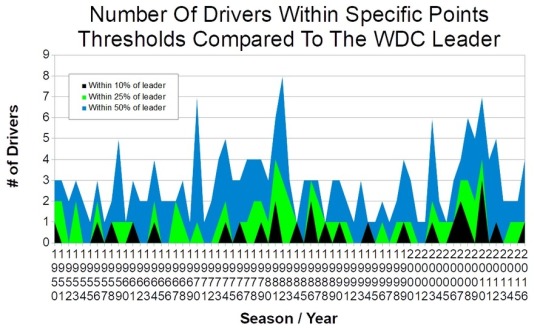
Although the World Drivers’ Championship between the Mercedes and Ferrari drivers has been quite entertaining this season, there are still some people that believe the current era of Formula One is boring. So, let’s see which era had the closest WDC battle via the statistics and everyone’s favourite data tool… graphs!

When searching for the closest era of World Drivers’ Championship battles, one must of course look at the points gap between the winner of the championship and the runner up. Naturally, the seasons in which the runner up driver was extremely close to winner of the championship title were more entertaining than seasons were the runner up was not in contention for the title, in most cases.
This is the perfect time to point out that this article is merely a statistical analysis. I, like all of you, have not watched every single Formula One race between 1950 to the present day, as that would require long hours trapped indoors on the sofa. Although I would love to do this, I’m most certain that my boss would not approve of me taking a vacation to do such an activity and I’m also certain that FOM would be quite angry with me for breaking into their archive room and borrowing years and years of race broadcast footage. But I digress.
There is an issue with comparing the points gap between seasons; this being that the points system has not remained the same throughout history. Drivers in the current era have been scoring a record high number of points. To compare the points gap between the WDC title winner and the runner up, I’ve decided to compile a graph (shown below) showing the percentage of points between the two drivers. To better explain, I simply calculated the number of points between the two drivers and figured out what percentage of the winning driver’s points the gap makes up.
For example, if the winner won the title with 100 points and the closest driver had only scored 90 points, the gap between the two is 10% because the 10 point gap is 10% of the 100 points that the winner scored.

So, what does this analysis show us? It shows many things.
On average, the runner up is 19% behind the leader. There have been 17 occasions in which the runner up was within 5% of the WDC title winner. There have only been 8 occasions in which the runner up was more than 40% away from the winner, most of which occurred in the ‘60s. The closest consecutive seasons were 2007 and 2008, both of which were won by a single point, equating to a 1% gap.
The largest ever gap between the winner and the runner up was a 48.2% gap in 1992. In this season, Nigel Mansell won the championship title with 108 compared to the 56 points scored by Riccardo Patrese. The smallest ever gap was a 0.69% gap between Niki Lauda and Alain Prost. This season was won by just half a point.
Now by this point you are probably saying “the leading battle is great, but the championship battle is about more than just the top two drivers”. I agree. That’s why I created a second graph (shown below) that highlights the championship battle down the rest of the grid. I used the same “percentage gap” concept from the graph above. This time, I counted how many drivers were within 10%, 25% and 50% of the leader by the end of the season. This gives us a better idea of how many drivers were in the championship contention.

This graph shows that it’s fairly rare for more than one driver to be within 10% of the WDC leader, showing that the championship battle is generally between just two drivers. On average, there are 0.4 drivers within the top 10% of the battle, meaning that there is one driver within 10% roughly every other season.
There was a range of seasons in which no drivers going get within 10% of the leader. This happened in the late ‘60s and early ‘70s. However, during that time there was one season were many drivers were within 50% of the leader. This was in 1970, when 7 drivers were within 50% of Jochen Rindt’s championship lead. This an amazing testament to Rindt’s massive dominance that season, considering he was involved in a fatal accident with four races remaining in the season and became the only post-humous World Drivers’ Champion in the sport’s history.
Now it’s time to determine which Formula One seasons provided the closest statistical World Drivers’ Championship battle in history. Based on the information presented above, I find that the seasons from 2006 to 2010 were statistically the closest battles. These seasons present the lowest average points gaps in Formula One.
Do you agree or disagree with this discovery? Let me know in the comments below and feel free to share your favourite season.